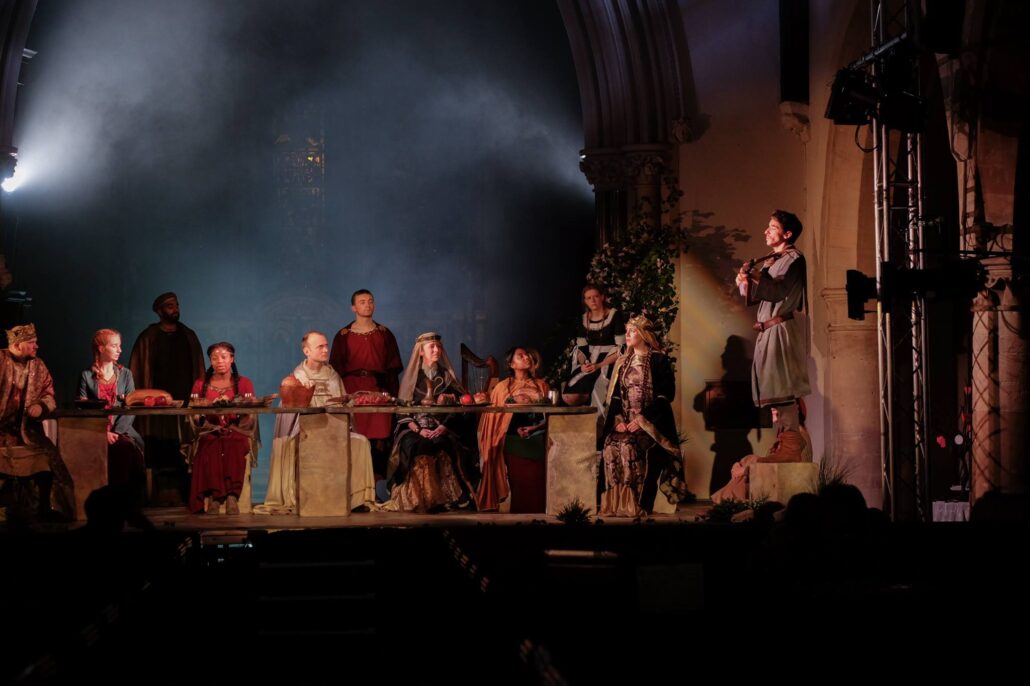Designing stage lighting with purpose

Designing stage lighting with purpose
Great stage lighting design goes beyond simply illuminating the stage—it enhances the performance and conveys the desired mood and atmosphere.
In step 2 of our guide to mastering production stage lighting, we discuss the importance of understanding the show's theme, mood, and narrative when designing lighting schemes.
We explore stage and event lighting techniques such as colour theory, gobo projections, and silhouette effects to create visually stunning compositions that support and enhance the overall production.
Key steps in designing stage lighting
Understand the Production
Begin by thoroughly understanding the production, including the script, storyline, mood, and overall concept. Discuss with the director, set designer, and other relevant personnel to gain insights into their vision for the show.
Determine Lighting Goals
Identify the specific lighting goals for each scene or moment. Consider factors such as mood, atmosphere, visibility, highlighting key elements, transitions, and special effects.
Create a Lighting Plot
Develop a lighting plot or plan, indicating the desired placement and types of lights for each area of the stage. Consider the different lighting positions available, such as front, side, and back, and choose suitable lighting fixtures accordingly.
Front lights are the primary source of lighting for most scenes. The distinction between warm, cool and neutral front lighting establishes mood, time and place. The colours used should enhance the scenery and complement a performer's skin tone.
Side lighting is primarily used to highlight the side of the face, arms, mid-torso and legs. A full quota of side lighting consists of bottom, middle and top lights, which reveal the three tiers of a performer's body.
High side lighting is a light hung at an overhead angle between 30 and 60 degrees. This accentuates the top side of an actor's head, neck and shoulders. Thus, high side lighting draws special attention to the facial expressions of a performer.
Back lighting creates greater depth and makes the performer appear multi-dimensional by separating them from the stage's background scenery.
Down lights highlight the top of a performer's head and shoulders. Downlighting is mainly used to wash or flood an area of the stage with soft or harsh light.
Choose the right lighting position to create a mood that fits with the characters, scenes and plots.
Choose Lighting Instruments
Select appropriate lighting instruments based on your plot. Common options include spotlights, floodlights, fresnels, PAR cans, and moving lights.
Consider their beam angles, color capabilities, intensity, and any specific features required for the production.
The basics of Stage lighting: Lighting instruments
Color and Intensity
Colours convey emotions, and colour theory can have a big impact on the emotions we feel when watching performances.
Although we all react to colours in unique ways, three psychological factors define these responses.
- Aesthetic. When you look at a particular colour, or a combination of colours, do you find them visually appealing?
- Emotional. As in, when you look at colours, how do they make you feel?
- Cultural meaning. Because of their use throughout popular culture, certain colours are more likely to convey particular emotions and concepts than others.
From a lighting designer's viewpoint, this third factor is crucial, as using specific colours is one of the easiest ways to set the mood on stage. Red, for example, is a colour that is often used to express feelings of danger, warmth or love, depending on the context.
Decide on the color scheme for each scene and moment. This can be achieved through the use of color filters or gels on the lights. Experiment with different color combinations to create the desired mood. Determine the intensity or brightness levels for each lighting cue.
Lighting Control
Determine the lighting control system to be used, such as a lighting console. Familiarize yourself with its capabilities and programming methods. Use the console to create lighting cues, which define the changes in lighting throughout the production.
Lighting Effects
Consider any special lighting effects required, such as gobos (pattern projections), strobes, smoke or haze machines, or moving lights with specific capabilities.
Gobo projections are stencils that are placed inside projectors to project an image or text. Great for projecting sponsor’s logos and brands, they can also be a great addition to weddings, gala dinners, charity events, and themed parties and are a growing trend.
A silhouette creates a nice sense of drama and mystery as well which can fit the mood of a scene/ Explore the art of silhouette through the world of shadow theatre.
Incorporate these effects into your lighting plot and cues to enhance the visual impact of the production.
Rehearsals and Adjustments
Attend rehearsals to observe the actors' movements and blocking. Make adjustments to your lighting plot and cues as needed to ensure the lighting complements the action on stage. Collaborate with the director, set designer, and other team members to refine the lighting design.
Technical Setup
Coordinate with the technical team to implement your lighting design. Install and focus the lights according to your plot, ensuring proper angles, coverage, and safety precautions. Test all equipment and ensure smooth communication between the lighting control system and the lights.
Dress Rehearsals and Fine-Tuning
Conduct dress rehearsals and make final adjustments to the lighting design. Observe the overall effect and make any necessary tweaks to achieve the desired results.
Conclusion
Your lighting design process may vary based on the size of the production, budget, and available resources.
Collaboration and communication with the production team are crucial throughout the design process to ensure a successful lighting design that enhances the overall performance.
Henley Theatre Services has been designing stage lighting with purpose since 2003 and are happy to help you with your lighting design.
Further Reading: Refer to our 5-Step Guide to Mastering Stage Lighting or proceed to Stage 3: Mastering Lighting Control.
About the Author
Joe Morris, Director of Henley Theatre Services runs the events side of the business, designing and creating some of the largest outdoor productions in the UK.

